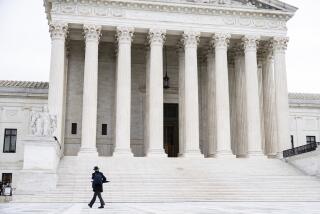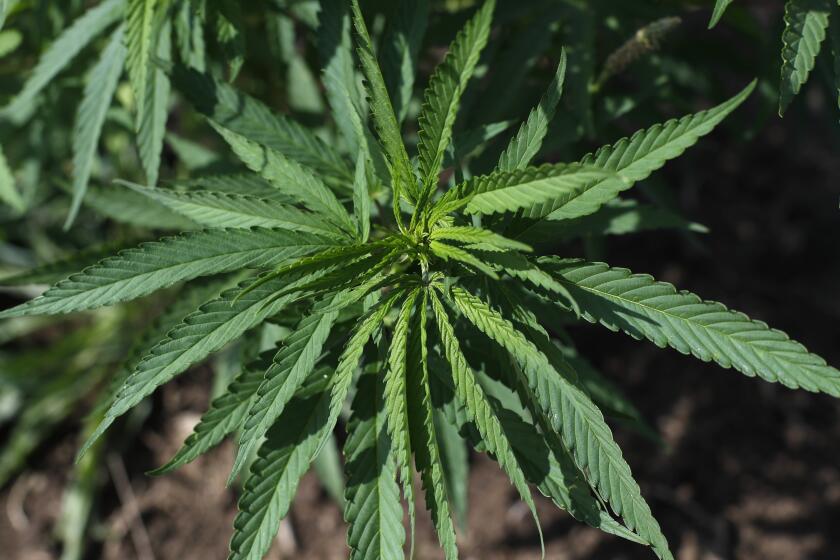Justices Allow Copter Sweeps for Marijuana
WASHINGTON — The Supreme Court Monday upheld police use of low-flying helicopters to detect marijuana plants, ruling that such searches do not violate a homeowner’s right to privacy.
The 5-4 ruling in a Florida case clears up most legal doubts about searches by hovering helicopters, which are employed widely by local and state authorities in California.
While upholding the actions of the police pilot in the case before the court, the conservative majority left unresolved exactly how low a police helicopter could fly without violating the Fourth Amendment’s ban on unreasonable searches and seizures.
“The helicopter in this case (flying at 400 feet) was not violating the law,” wrote Justice Byron R. White in a terse opinion, because Federal Aviation Administration rules permit helicopters to fly at that altitude.
“No intimate details connected with the use of the home or curtilage (yard) were observed (by police) and there was no undue noise, wind or threat of injury. In these circumstances, there was no violation of the Fourth Amendment,” he concluded.
The ruling is in line with more than a dozen opinions in recent years giving police more authority in the war against drugs. In 1967, the Supreme Court said that the Fourth Amendment protects a citizen’s “reasonable expectation of privacy” in his home, yard, automobile or person. But in recent opinions, the high court has narrowed the definition of what is reasonable.
For example, the court has said in the last year that police can search garbage cans outside a home, baggage at airports and a closed container in an automobile--all without search warrants.
In the case decided Monday (Florida vs. Riley, 87-764), the Florida Supreme Court had ruled that police violated the Fourth Amendment by hovering at 400 feet over a greenhouse owned by Michael Riley. State prosecutors appealed this conclusion and won the reversal.
Justice William J. Brennan Jr., writing for himself and Justices Thurgood Marshall and John Paul Stevens, said that the court ruling raises the specter of “Big Brother is watching you” in George Orwell’s “1984.” He pointed out that the police in Orwell’s totalitarian state used helicopters to “skim down between the roofs . . . snooping into people’s windows.”
“Who can read this passage without a shudder, and without an instinctive reaction that it depicts life in some country other than ours?” Brennan asked.
Justice Harry A. Blackmun filed a separate dissent arguing that police should have to demonstrate that their search was reasonable, rather than force the homeowner to prove it was unreasonable.
Two years ago the U.S. Supreme Court created some uncertainty about the legality of helicopter searches when it left standing a California appellate court ruling. In that case the state court threw out a marijuana-growing charge against a San Diego man because police spotted the plants from a helicopter flying at 400 feet. Neither the California Supreme Court nor the U.S. Supreme Court agreed to hear the prosecutor’s appeal.
Laurence Sullivan of the California attorney general’s office said that helicopters are used widely in the state’s Campaign Against Marijuana Planting. However, state officials have agreed in a court consent decree that they would not fly below 500 feet, he said.
But city police and county sheriff’s departments use helicopters that fly at lower altitudes, he added. “This ruling says that it is not a per se Fourth Amendment violation to be flying at 400 feet over someone’s back yard,” said Sullivan, a supervising deputy attorney general in San Francisco.
The Los Angeles Police Department does not have a policy limiting how low police can fly in helicopters. “It is a case-by-case situation depending on what is required. We don’t have a minimal altitude policy,” said Lt. Fred Nixon, an LAPD spokesman.
More to Read
Sign up for Essential California
The most important California stories and recommendations in your inbox every morning.
You may occasionally receive promotional content from the Los Angeles Times.











